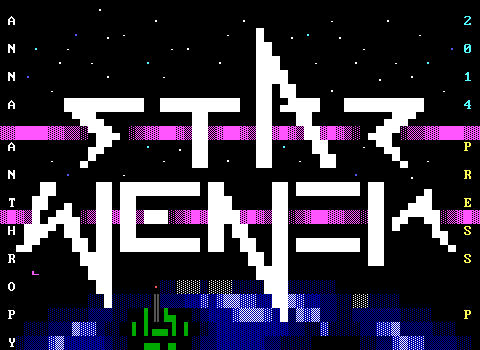The poll winner for October was the rather appropriate Bloodlines: Disc 1, a game about vampires. Up to this point, none of author Chase's games have been showcased in any way, and well, we'll get into why that's the case soon enough. My personal experience with his games has been kind of spotty. I had never checked out the two "discs" that make up the Bloodlines series, though I had some idea of what to expect from having played other releases of his along with knowing a bit about his reputation within the community when he was still active. Growing up, his sci-fi stealth game Operation: OBRIAN captured my imagination with the story of a military training exercise gone wrong resulting in a peaceful planet now being targeted for orbital bombardment. The unique gameplay of avoiding security cameras, stopping movement during motion scan, and "files" as they'd be presented in a survival horror title being played out as video logs of deceased crew members really left a mark on me. (So much so that I even wrote about it before starting the Museum.)
Despite my reluctance to spending some time with one of Chase's games for the site, I also at one point found myself considering streaming Final Fantasy Disc One after spending a few weeks with various unpreserved JRPG fan games, before deciding against it because well, the reviews talking about how slow and boring the game is are remarkably accurate given the usual quality of z2-era reviews. That and the other issue that I'll get to soon enough...
So, from my perspective, his games are a definite mixed bag, and while I liked OBRIAN, its flaws are pretty blatant. Ultimately, I wasn't expecting too much from Bloodlines, at best another instance of some good ideas with mediocre execution. Well, it must have been my lucky day as Bloodlines wound up being one of the more compelling ZZT games I've played, and is easily a new personal favorite of mine. The game shows an impressive level of design sensibilities that frankly are lacking in Chase's later releases, but more importantly this isn't just a very good Chase game, it's a very good ZZT game. Taking one of the most common styles of adventures around the turn of the century and incorporating a lot of excellent ideas held together with one of the more captivating stories I've seen in ZZT. Put it all together and Bloodlines ends up being a fantastic experience from start to finish with only the smallest of issues getting in the way.
Unfortunately, while the game itself is excellent, there are two big stumbling blocks that make it a lot harder to enthusiastically recommend today:
The Legacy of Kain
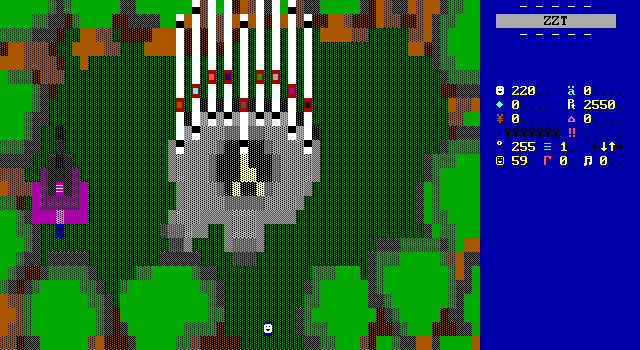
Back in Chase's ZZTing days, he had a bit of an issue with passing off other people's stories as his own. Not as in stealing work from other ZZTers, but from just lifting plots from various video games by professional studios. Reviews for Final Fantasy Disc One repeatedly go into how the story and characters are from the PlayStation 1 RPG Suikoden. Bloodlines takes a number of names, locations, and world design from Blood Omen: Legacy of Kain and once again the game's z2-era reviews are quick to point this out. I have no experience personally with the Kain games so I can't really speak too much into just how much of Bloodlines is unoriginal work, but cursory looks at a fan wiki as well as the Wikipedia page for the first game make it seem to be a fan work with a semi-original story with various names of Kain characters shuffled around.
This gets even more blatant with Operation: OBRIAN where the opening cutscene has been discovered to be taken word for word from the game Iron Helix. (Thanks to Agent Orange and The Green Herring for catching the "reference material" for that one!)

Which is the first of many things about Chase that are a shame.
Fan-made ZZT worlds based on existing games have been with the medium for a very very long time, and have never had a poor reputation. Outright conversions like Nadir's Dizzy ports are iconic inventory adventures. Original creations with established characters and settings can be found in plenty of beloved Interactive Fantasies releases. King's Quest games, Quest for Glory, and Indiana Jones are solid adventures enjoyable with or without the context of their source material. Heck, even Death Gate puts a ZZTer spin on things. There are of course countless fan games of subpar quality. Final Fantasy II 1/4, or most Final Fantasy inspired ZZT games on the mid-90s are enough to prove the point.
The thing is, these games all make it clear that they are based on something else out there, and so they come off as celebrations of these games the authors of these ZZT worlds were inspired by. Bloodlines opts to hide its Legacy of Kain connection entirely, and so had it not been for the helpful reviews, and knowledge of Chase's habit of masking his inspiration I would certainly have some positive feelings towards the game that belong to Silicon Knights instead.
It's a shame (there's that word again) because just giving that little bit of credit anywhere, whether that be the main menu, text file, or the end credits would be enough to get me on board entirely with the game as it is. Instead, I'm left with mixed feelings on the game's story line, which is a surprising potent piece of Bloodlines. I was quite invested in the story in a way that honestly very few ZZT games, especially those released two decades ago, have accomplished. Instead, after finishing "Disc 1" I was unsure if the correct action would be to plan to play Disc 2 or to plan to check out the Kain series twenty some years late.
The Legacy of Chase
The following content discusses events which may be upset some audiences. Unlike the usual Museum content warnings, this discusses actual events and not in-game content.
Specifically, this portion of the article discusses:
Murder
But boy what I wouldn't give for Chase's legacy in the ZZT community to be "bad at giving credit" due to Bloodlines or "great graphics, subpar execution" from reviews on Final Fantasy Disc One and New Earth Operations (NEO). No, instead the legacy of Chase is that he was convicted of murder and sentenced to 16 years to life in prison.
By the time this went down Chase had already moved on from the ZZT community, with his final release being the aforementioned Final Fantasy in early 2003. There was speculation on whether or not this was the same person, but in addition to matching full names, other more specific details pertaining to working in film production made it pretty clear that was a murder by a well known ZZTer still in then-recent memory.
Which is partially why after six years of creating articles for this site, I hadn't exactly gone out of my way to play one of Chase's games.
His games could have been excellent examples of what high-concept ZZT games could be. What might have been a ZZTing legacy of ambitious games featuring some of the best visuals and animations seen in their day (with or without spotty execution) instead was brushed aside, replaced with an anonymous z2 review posted on NEO:
Any time I considered playing one of Chase's games, the question ultimately came down to whether or not I wanted to draw attention to his work, and his crime. That's why it took a patron poll to get me to finally pay a Chase game a visit. I won't be bringing up Chase's actions elsewhere and will be treating this game like any other. The only difference is that any overall recommendation comes with one hell of an asterisk on it. This is a very good ZZT game, but it is not the only very good ZZT game around, and plenty of the others can be played without baggage this severe.
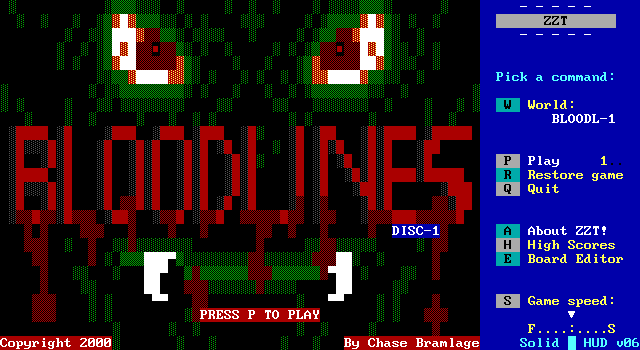
Bloodlines is a mix of a few staple ZZT genres. It's a fantasy adventure where you explore a vast world visiting unique landmarks. It's got a hint of dungeon crawling thanks to its many dungeons scattered across the land. It's got drama! Oh boy does it have drama. Allegiances are broken, friendships are betrayed, and something more sinister is lurking in the background biding its time. The gameplay is old fashioned in some instances, while modern to a cliché in others. There's quite a lot going on in this game, and Chase genuinely puts it all together quite exceptionally.
This article covers only the first "disc" of the game, a popular term for splitting ZZT games across multiple files in the PlayStation era. However, this is not like most multi-file games where every file is part of a single package. Disc one was released independently with the second disc being released shortly afterwards, along with a bundled package containing both discs. Today I think the best way to understand it would be to compare it with episodic gaming.
Despite the split, there's still a significant amount of game here, more than enough to get you invested in the game's world and likely making for a few weeks of anticipation for those who played it prior to the second disc's release. The reception to disc one was definitely positive as it received a coveted Game of the Month award where it was described as being created by "a relatively unknown ZZTer". That's quite the feat for a then newcomer to the ZZT community. January of 2000 also saw the release of Tseng's long awaited sequel Gem Hunter 3. It's no easy feat to rise above such an established and respected name in ZZTing so quickly.

Among Chase's credited releases, Bloodlines is his second release, and looks to be quite a step up from his first released game: Boof. Bloodlines certainly doesn't feel like a second game, incorporating so many concepts into one game in a way that feels incredibly natural. Unlike say, coolzx's A Dwarvish-Mead Dream, which switches up gameplay styles chapter by chapter, Chase manages to fit all his designs into one cohesive world. I was surprised at how well-designed the game really is. Despite most of the game not being anything particularly new to ZZT games, Chase always manages to keep the gameplay interesting and was able to hook me into the story to the point where I was begrudgingly doing optional plot-free side-content for the sake of the article rather than barreling ahead to see what was going to happen next.
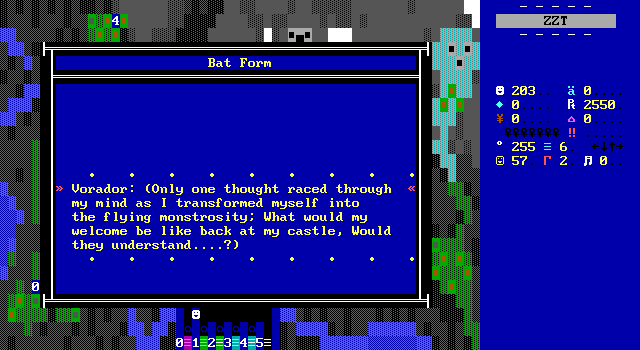
Of course again, what portion of that story is Chase and what is Kain makes it hard to say who's really succeeding here. Even if this is wholesale Silicon Knights, converting something like this to ZZT is no small feat. Tseng's humor allowed his Parasite Eve ZZTification November Eve to detach itself from the source's serious story, making it immune to criticism from that angle as you're supposed to laugh at it. Chase genuinely works to make you interested and does so in a way that few others before or after in ZZT have managed to accomplish. Short of him transcribing cutscenes word for word, the writing here is the strongest aspect of an already quite competent adventure which makes Bloodlines a refreshingly unique experience in a medium saturated with teenage dramas that elicit limp reactions today.
The People And Places of Nosgoth

Set in the world of Nosgoth, the player takes on the role of Vorador, a holy knight working with an organization known as the Sarafan. The world of Nosgoth is plagued with Nosferatu! Your order is tasked with cleansing them and freeing your lands from their terror. This ends up being a rather short lived goal as the very first thing to happen in the game is for Vorador to be caught in a surprise attack and turned into a vampire himself.
So more accurately, the game is about Vorador experiencing "life" as a vampire, seeking a cure, and trying to resist succumbing to his new dark self while his former brethren reject him on sight.
Complicating things even further is the hint at a more substantial plot than merely vampires versus humans thanks to the "Circle of Nine" that serve as guardians for the land. Bloodlines honestly doesn't do much with them, and save for a trip to a monument for these guardians, they don't really do much barring one of them coaxing Vorador into speaking with the vampires and helping him learn the truth about why he was made a vampire in the first place. The Legacy of Kain Wiki leads me to believe that the whole corrupted pillars thing was clearly intended to apply to Bloodlines as well. In the first disc at least, it's almost nothing.
People?
Vorador - The game's protagonist. A Sarafan soldier sworn to protect Nosgoth from the very creature he's become.
Malek - Vorador's best friend and commanding officer. Originally believed to be Vorador's only hope in convincing the Sarafan that he's not a monster (yet), his true motives reveal him to have a thirst for power and to be willing to do whatever must be done to rise up the ranks of the Sarafan.
Mortanius - Guardian of the Pillar of Death. He guides Vorador out from his despair and towards the truth of what Malek is up to.
Yanos Odrin - The vampire who is responsible for Vorador's death and vampiric rebirth. He believes Vorador will determine the fate of Nosgoth and allow the war with humanity to end in the vampires' favor.
Places
Nosgoth Woods - A forested area in Southern Cross, the border area between lands belonging to the living and lands belonging to the dead.
Hammerstein - A small human settlement in the Nosgoth woods. Good people. Tasty people.
Jy'Had - The village of the vampires. Home to Yanos Odrin, his council of vampires, and their war room.
Steinchencroe - A major fortification of the Sarafan. The first planned target of the raids with Vorador.
Coorhagen - A larger human settlement up north. Are they aware they built their town next to a cave with a blood-pouring fountain? Stupid people. Tasty people.
Blood Fountains - Not just found in Coorhagen! A few caves are set up for vampiric rituals where Vorador can drink from these fountains and enhance his abilities.
Spirit Forges - Obviously not welcome in human shops, Vorador can instead make deals with dark spirits. In exchange for a considerable amount of power (health/blood), he can receive a considerable amount of items.
THE HUNGER and Other Gameplay Mechanics

By far the most unique feature of Bloodlines is THE HUNGER (stylized in all caps in the game's manual). As a vampire Vorador needs bloods to survive, and lots of it. THE HUNGER system is used to implement this vampiric tendency. On every gameplay board an object slowly ticks away your health. If you're unable to acquire enough blood, you will die on the spot. The ticking is pretty slow though the player's own uncertainties about what the game might throw at them next make it a priority to keep making deposits into Vorador's blood bank.
Realistically, it's a gimmick. It is extremely easy to acquire blood in vast quantities whether by drinking the blood of your enemies, the innocent, or finding conveniently placed vials of blood, there's always a source close by. Yet the psychological effect is undeniable. Plenty of ZZT games have had players wandering through a forest with enemies intended to be fought in close range combat that often is better off ignored rather than engaged in. THE HUNGER serves as a highly effective motivational tool. Enemies on the overworld are pushovers, but thanks to the tangible reward for defeating them I found myself far more invested in fighting my thirty-seventh wolf as I could never know if there was going to be a drought of foes in the near future. Better to drink blood now rather than be thirsty later.

The slow drain is also ideal since it allows the game to maintain similar pacing to most ZZT adventures. It would be easy to adjust how much blood is received or how quickly it drains and transform the game into a rush to get through it in time. The system as it's implemented takes a typically weaker component of ZZT-forest-adventures and makes it compelling to participate in combat for a change.
Chase appears to have experimented with the drain at least somewhat, as an unused BLOOD flag is checked for which will slow the draining dramatically. Perhaps something like this would be useful as a late game power-up, but the rate of blood-loss here is best left untouched in my opinion.
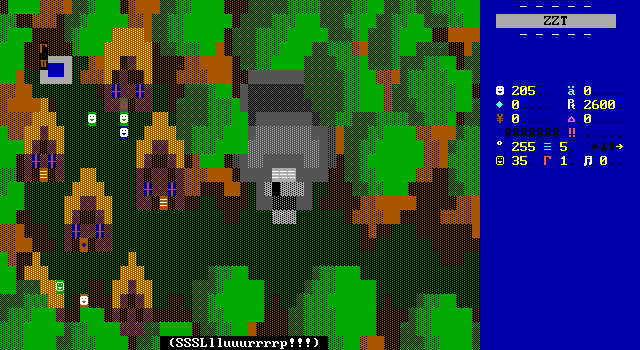
Of course, the question is how does one go about slurping the blood of wolves, bears, and people? Like many ZZT games of the era the combat is primarily melee focused. As a (former) Sarafan, Vorador is equipped with a sword which is used to attack his targets. And now possessing inhuman strength, it doesn't take much for Vorador to take down his prey. A single touch is all it takes to defeat any of the game's enemies that are vulnerable to the sword. The blood draining is not an automatic process. The first touch "stuns" enemies, locking them in place for a moment and providing Vorador with an opportunity to touch them again to feed. However, enemies never recover, and so ignoring a stunned enemy to focus on another will result in the stunned dying after a moment, turning themselves into a bloody red fake and denying the free health.
Once again the system as is implemented works great. There might be some room for improvement with things such as requiring Vorador stand next to a stunned target for a moment in order to feed as the current design makes it so easy to feed that there's never a reason not to. Making oneself vulnerable by having to anchor to a spot might help in that regard. Admittedly, this is an untested hypothetical. The odds are that tweaking things would be more likely to make feeding worse rather than improving it in any meaningful way.

In addition to sucking blood and swinging a sword around, ranged combat is also an option. Throughout the dungeons of Nosgoth, Vorador can find "Flays", another Kain component. The game offers no description of the item so it's a good thing this wiki was here. These are represented with ammo and are used by just having the player element shoot. Foes defeated with this weapon are killed instantly and deny Vorador the opportunity to drink blood, so I found myself rarely bothering with them. The exception to this is of course the handful of enemies found in dungeons that are only vulnerable to these weapons, some of which are object based, though others are just straight up ZZT tigers and centipedes (appropriately themed of course to skeletons and... slimes? Those are kind of already a thing in ZZT.)
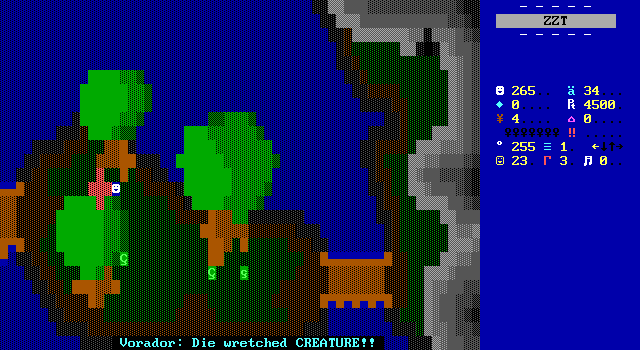
Speaking of combat, one nice touch is that Vorador and the enemies often have words as they fight. Wolves growl when they see the player, and Vorador has a line or two of his own as he slays them. This is something that I recently praised Zephyre Syx's 2004 game Pepper Bolette SE for, saying that I wished more games did something like this to liven up the combat a little via text rather than relying on visuals and/or narration. Well, here's another example four years earlier. Credit to Zephyre, Pepper Bolette implements randomization of these one-liners and calls them as needed. Chase's options are merely hard coded and repeated throughout the game making them a lot more repetitive than the per-board trash talk of Pepper Bolette.
Besides the flays, there are a few more items to collect. Blood vials being the most important one and serving as a common reward item for completing one of the game's dungeons. They provide 100 health which is how THE HUNGER can end up being pretty easily staved. There is no upper maximum on your health implemented so chug away.

Other items are upgrades to Vorador's vampiric abilities. These consist of "cards" that give new abilities, which might sound like a cool Metroidvania thing, but really are abilities used at fixed points and abilities that serve as faux "keys" for obstacles that are no different than locked doors. For example, Vorador will gain the ability to transform into a bat! That sounds neat. The way it actually works is that you come across "Bat Towers" that take you to a map screen and let you fast-travel around the world in bat form. Symphony of the Night this ain't. (It's Legacy of Kain, remember?)
Another card mentioned in the manual and by various NPCs in the game is the mist card, which allows a transformation into mist. Various vents can be found throughout the game's dungeons and with the transformation Vorador can acquire a lot of otherwise unobtainable items. It unfortunately comes so late into the game that by the time you can even acquire it, you can also walk to the ending board which makes it kind of pointless.
The Incredible ZZT Sucker
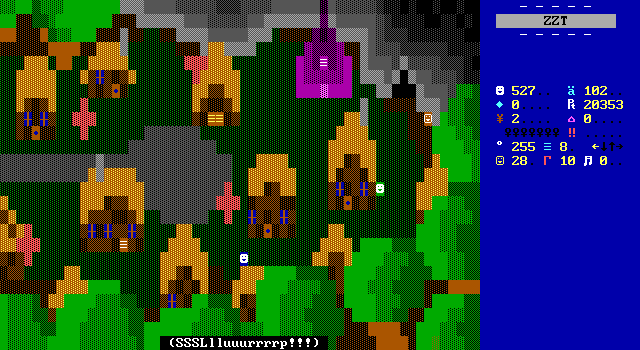
As mentioned, the blood sucking attack isn't just a coup de grâce for those who decided to attack a vampire. Vorador is very much able to visit human villages and suck the blood of anybody he comes across. This is undoubtedly the most novel thing about the game. Vorador was already supposed to be a strong soldier, but now blessed/cursed with the powers of the undead he is very much meant to be a tremendous threat to humans when he embraces his newfound vampiric desires.
It is a wonderful twist on the established ZZT convention that the town is a sanctuary from the untamed wilderness that surrounds it. Rather than welcome the player to rest and shop and converse with the populace for important information, Vorador instead descends on these unprotected towns and instead drains the blood of everybody in them. It's an excellent way to establish Vorador as someone to be feared. Not one human villager in the game tries to talk with help Vorador. No, instead they are effectively livestock, and his for the taking. The towns are still sanctuaries, just not for those who live there.
The village boards really have no comparison other than perhaps the "Gem Powered Microwave Oven" from Aceland. Aceland however treats its destructive power as a joke. Once acquired everyone and everything fries, and it's played off humorously. For Bloodlines, the populace will scream in terror when they spot you, yelling for help or to warn others that a vampire is in town. There are no guards or desperate attempts at escape. The villagers will run, scream, and inevitably have their blood consumed.
Your reception in these towns does an excellent job at reminding you of what Vorador has become and how much of a threat he is to those who aren't trained to deal with vampires. In terms of design, villages are a brilliant way to provide the player with more health. It is far more distinct than drinking blood "earned" in dangerous encounters or stumbling across a video-gamey phial of blood just lying on the ground for your benefit. It works with the game's theme in a way I loved.

Its enhanced even further by the fact that a few of the buildings will allow the player to enter. Once inside sleeping villagers (who must work the graveyard shift) can be relieved of their blood as well. We're talking boards dedicated to having a single object in a bed just because it's such vivid imagery that ZZT rarely gets to work with.
My only real complaint is the location of the first village is so early in the game that it's very possible to drink the blood of an entire village leaving it deserted, and then a few minutes later transform into a bat and fly back to anti-vampire HQ and politely ask if you can still be friends. I genuinely thought this must be a game with a path for giving in and a path for resisting, but no, whether or not you create a new housing market in town before pleading for help in finding a cure and asking to remain a protector of the people things play out the same.
Dungeon Crawling For Fun And Profit
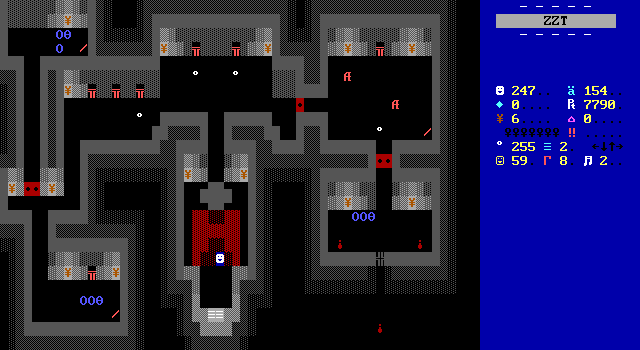
The final component of gameplay consists of the dungeons scattered throughout Nosgoth. Chase is upfront in the manual that every single one of them is completely optional. On paper, dungeons exist as a way for Vorador to gain resources that are find in the overworld, making them a prime location to explore if you ever managed to find yourself low on health.
The dungeons really help to fill out the world and allow it to sidestep the sort of flaws you often see in games with lots of wandering around in the woods. The limited variety of foes to fight as Vorador walks from point to point could get a little tedious. Having dungeons lets the player shift their focus momentarily and get a break from the basic style of gameplay. Making them optional as Chase does is an excellent way to let the player dictate when they need a break rather than leaving the pacing at Chase's discretion. There are six of these scattered throughout the world. Five of them offer up non-unique rewards: blood vials, flays, or both; while the last dungeon (that appears too late to really be beneficial) provides the Mist card used to get through vents.
That Mist card gives you reason to back to certain earlier dungeons to get even more supplies from them, and in theory if this game had been released as a single file (impossible due to the memory constraints) its timing wouldn't have been a problem. Clearly the Mist card is a much more valuable reward than the other dungeons, so you might expect a complaint about not knowing whether or not a dungeon is worth the reward until the player has already conquered it. Even with the basic rewards, if you're venturing into a dungeon due to a low amount of blood, if the dungeon doesn't offer up any vials you're likely to leave in worse shape than you entered.
Chase came up with an elegant solution that also fits right in to the world of Bloodlines. The entrance-way of every dungeon has a symbol drawn on the floor comprised of fake walls that depicts what the reward is.
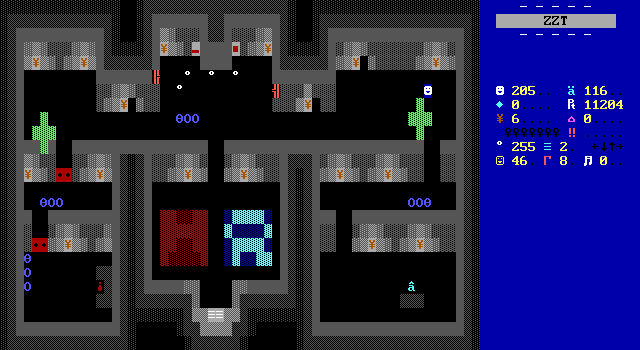
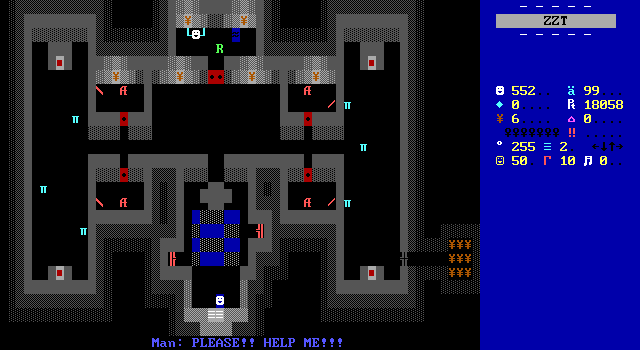

These symbols are meant to pair with the characters used for those items so it's pretty easy to remember which symbol is which, and upon seeing the unexpected 3rd symbol for the Mist card, you might not know what it is, but you know that it's something new and that you should definitely want it.
The dungeons themselves are rather breezy ventures. Every dungeon consists of just a single board broken up into smaller rooms. This gives them quite a different vibe, almost arcade-feeling, than ZZT games focused on dungeon crawls including Anthony Testa's Asmodeus and Nadir's Psyche. In addition to their smaller size, they are notable for containing undead foes, which is just in-universe the justification for using built in ZZT enemies that will harm the player if touched as opposed to being compatible with Vorador's bloodsucking lifestyle.
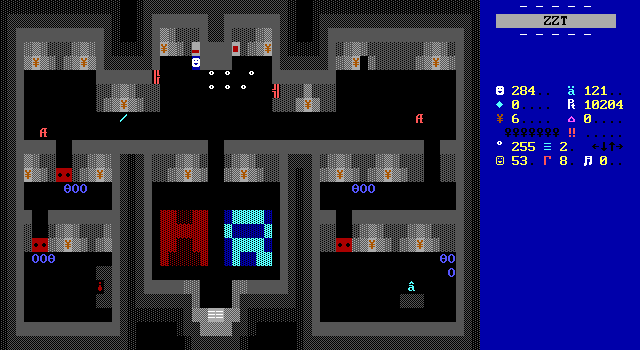
Navigation through dungeons is generally fairly straightforward, with only one of them using darkness to hide their contents from the player. You'll find buttons and levers necessary to open doors, vents that hide hidden paths to more items, and plenty of traps that are just objects shooting bullets in a tandem with one another. Credit where it's due, the dungeons are actually quite a lot of fun regardless of your need for the rewards. Chase very well could have made a traditional dungeon crawler in this design and still have had a hit. Lucky for us though, we get the best of both worlds with a rare instance of a game being split into an overworld and underworld with both parts surpassing expectations.
In some instances, the player will be unable to actually make it past the entrance as large boulders serve as obstacles to get past first. As Vorador powers up he's gains the ability to pick up boulders with relative ease. Again, this works out in favor of the world design. The bat towers allow the player to navigate to already explored (and likely devoid of sources of blood) areas quickly. This is intended to let Vorador revisit overworld boards with new paths opening up once he has reason to journey to new locales. As the story progresses, the player gets opportunities to return to these dungeons without having to go out of their way to make a dedicated trip to a dungeon.

